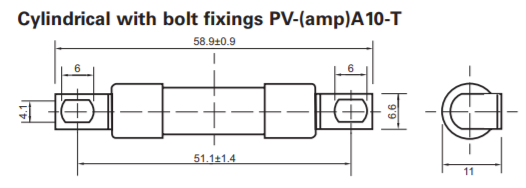jray3 said:
Here's the spec sheet for our 20A fuse under the inverter inspection cover. Still haven't found an online vendor.
The nearest equivalent I have found so far isn't great. It's a Bussmann/Eaton PV fuse, part number PV-20A10-T, which is surprisingly rated at 33 kA or 50 kA of interrupt capability (what panels can manage anything like that? Perhaps in a commercial solar farm).
It's available from Mouser US: https://www.mouser.com/ProductDetail/Bussmann-Eaton/PV-20A10-T?qs=sGAEpiMZZMvnfWYzRsH6EbYZ2445BpOV
It costs around US$30 and won't be in stock for several weeks (as of this post in early July). Digi-Key
have it as non-stock item, meaning they will order 10 of them for you if you want, and the unit price is even higher (around US$358 for quantity 10). Newark/element14 and RS-Online don't seem to stock it.
It's also too big: it's a 10x38 mm fuse, so the holes are 51 mm apart (49 mm minimum assuming M4 bolts). [ Edit: It's probably a near-exact or exact fit; see
this post. ] So you could cut off the ends and nibble or drill the slot to take the presumed 45 mm spacing of the bolts. Totally non-ideal, but if Mitsubishi are out of stock, this might be a solution for the adventurous and/or desperate.
Littelfuse don't seem to have anything suitable. The closest seems to be their 504 series: http://m.littelfuse.com/~/media/electronics/datasheets/fuses/littelfuse_fuse_504_datasheet.pdf.pdf
But these are leaded fuses (you could bend the pigtails into a loop), and the killer is the interrupt rating: only 400 A @ 420 VDC. The slightly low voltage rating would I believe be adequate, but I think you'd want every bit of the 2000 A interrupt rating of the original PEC fuses.
[ Edit: Added image; Bussmann -> Bussmann/Eaton ]

































